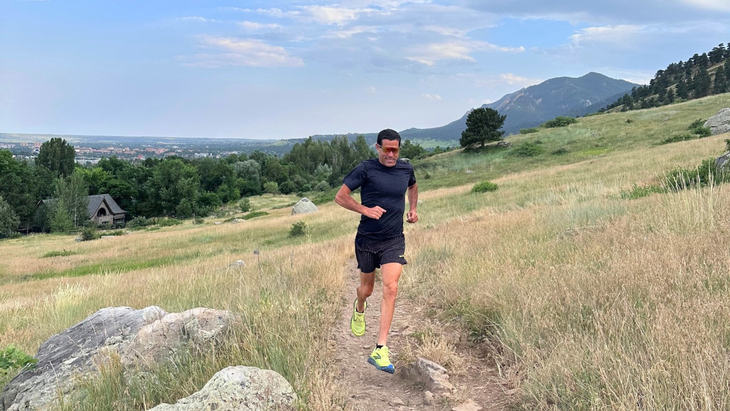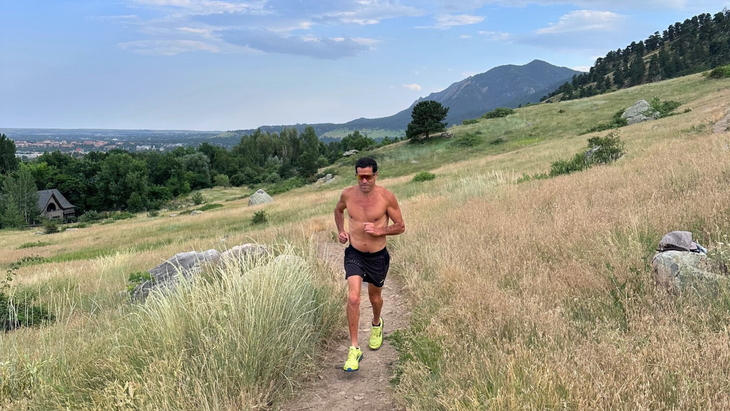New perk: Easily find new routes and hidden gems, upcoming running events, and more near you. Your weekly Local Running Newsletter has everything you need to lace up! Subscribe today.
Like most oft-discussed topics in the running world—the professionalization of trail running, influencers getting free race entries, or running a marathon with no training, there are always two sides to every argument. In this piece, we’ll tackle an issue that comes up increasingly in online message boards, social media, and over post-run beers: “noise pollution” from trail users blasting music or taking loud calls on speakerphones.
Here, Adam Chase, the longstanding president of the American Trail Running Association—and coincidentally a practicing attorney—argues the case for/against human-powered trail noise, facing possibly his toughest opposing counsel yet: himself.
Be Quiet! The Case Against Noise Pollution on Trails
By Adam W. Chase, Silence Aficionado

On a recent press trip in New York City, I used the hotel gym on a rainy morning and was accosted by a guest conversing boisterously on speaker phone while pounding it out on the treadmill. At least three other hotel guests were working out in the condensed gym and the cacophonic phone user wasn’t phased in the slightest. While I personally found this unusual and quite rude, I dismissed the conduct as simply foreign—me being a relative country bumpkin visiting from my mountain hometown.
However, upon returning to Boulder, Colorado, I had several encounters with hikers and trail runners carrying on high-volume phone conversations—one or two via video, and others using speakers to openly blast tunes—all while on public trails. Is this becoming a global trend, I wondered? Is it now a common occurrence and I’m just gaining awareness? I’ve asked other trail users in my own circle, and they agree the escalation in both frequency and volume has become a common phenomenon.
As the long-time president of the American Trail Running Association, I try to have my finger on the pulse of proper trail running etiquette. And, as my “tenure as a human” grows, I actively try not to be too much of a salty, get-off-my-lawn trail goat who fails to go with the flow. Then again, I’ve also been around long enough to be able to name the original artist being sampled in the brand-new tunes thumping along the trail.
While I don’t personally run with a watch or phone, as a gear reviewer for this publication I’m no Luddite and take pride in staying up with the leading technologies. Having said that, I also greatly cherish the peacefulness one finds in nature and the equanimity one gains from bird chirps, the sound of wind, and the rhythm of one’s breathing and footsteps. To me, a crucial element of trail running is being aware of one’s surroundings.
So, what’s up with folks obliviously violating that tranquility?
I run trails to get away, to escape. Loud phone conversations and music disturb that serenity, not to mention frightening wildlife. To me, the behavior harshes nature’s buzz and is psychically akin to smoking on the trail—or leaving dog excrement.
Or should I join the modern times and appreciate that tech and nature can peacefully co-exist?
During one of my law school summers, I was lucky enough to sit in on a trial where a lawyer from the firm where I was clerking represented a citizen group opposed to the placement of a government administrative building in a city park. The pro bono attorney quoted Frederick Law Olmsted, landscape architect of America’s most prominent green spaces, including Manhattan’s Central Park, in arguing that the building would violate the essence of the park as a restorative public preserve.
In that vein, I have idealized trails as fluid parks. Offensive phone conversations block that flow.
Be present.
Wake Up: The Case for Tech Freedom on Trails
By Adam W. Chase, Vibin’

Get off your high horse, boomer; don’t be such a simp.
Trails belong to everyone, not just those who have been using them since time immemorial. Your myopic, elitist perspective fails to account for the generations of people who feel alienated from park lands and will be using them long after you’ve taken your last dirt nap. Your exclusive attitude is deaf to the comfort some derive by transporting technology and tunes to quell otherwise unfamiliar environments. Those sounds allay fears and make newbies more comfortable.
“Old school” trail runners probably don’t understand how they come across to potential users—relative neophytes to the outdoors who are unfamiliar with uninhabited spaces. A phone conversation can serve as a security blanket to those otherwise put off by being alone in the woods. There is safety in sound. And if entering a wild country with someone on the other end of the phone allows some folks to overcome anxiety, that is a positive and should be encouraged—if not at least allowed—without holier-than-thou judgment from those who have long been at home in secluded spaces. Technology is progress, wake up and get out of the way.
Don’t fence out would-be trail users, especially those hailing from urban places, reserving remote areas for those who have historically made use of such natural spaces. These are public lands to be considered shared spaces to which we all deserve equal access.
Old school trail runners should acknowledge their own physically privileged positions, share in the bounty, and roll out the welcome mat. We should be more considerate and inviting to folks less comfortable or experienced. “Come” we ought to say, “Join the party. The more, the merrier.”
Besides, when it comes to rights, there is no legal protection guarding silence. The Coase Theorem, a foundational principle of law and economics attributed to Nobel Prize-winner Ronald Coase, explains the economic efficiency of distributing externalities—such as speaker phone conversations or blasting tunes—when there is low or no transaction costs. Basically, if those seeking silence could bargain with those disturbing it and the latter had the legal right to such behavior, the silence seekers would have to pay the cell phone users to cease their disturbances.
Put another way, one might ask who is causing the problem, the person “shushing” on the trail or the one being shushed?
One person’s negative externality (i.e., noise pollution) is another’s joy (e.g. talking with a friend or listening to music). Because rights are clearly defined, giving technology users freedom to blare at will, other trail users must negotiate with them, according to the Coase Theorem, and an efficient allocation of silence or sound should result. Since there is no law guarding your quiet, silence seekers need to offer enough to keep the peace.
Besides, are you going to object to a lively IRL conversation among hikers? How dare they disturb the silence? Is your sacred trail space now acting as a library?
I’ll give Frederick Law Olmsted the final word. As the visionary social reformer he was, he pushed against discrimination between different classes of people, where rich people had most of the enjoyment of private lands and poor people didn’t. He sought to increase social interaction, and contributed his designs to enhance public health. Understanding the eco challenges of urbanization, his parks were designed to create inviting environments, and that philosophy must move forward.
Be inclusive.
